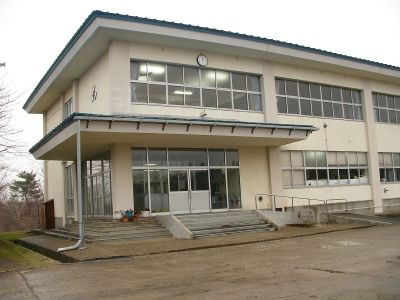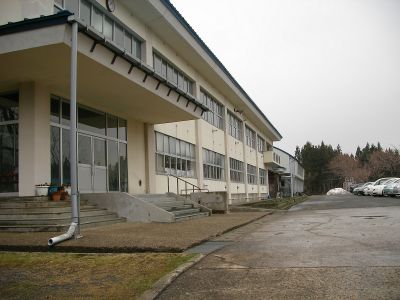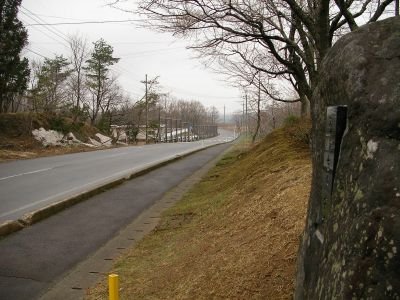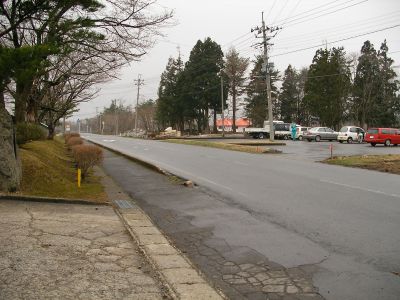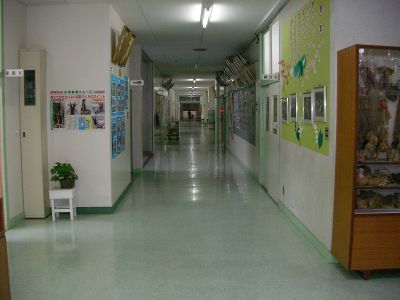Yesterday I promised that I would talk about the new school I am visiting, Kamagadai Shochugakkou.
I have been to Kamagadai twice since term started. Last week, I was picked up from outside Konoura Jr. High at 8.30am and taken by town car to Kamagadai. There was significantly less snow than there had been when I visited during spring vacation. When I got to school, I met the English teacher Mr. Sato. He is the husband of Yumi sensei the school nurse who left Konoura Jr. High the other week. Small world, huh? He has also just moved from another school, so the students don't really know him either. Anyway, we discussed the day's lesson plans, and then I talked with the Vice Principal. Kamagadai has a lady V.P. who is very, um, loud and genki. She kept unselfconsciously speaking broken English to me, which I thought was really good.
From 9.30am until lunch I was teaching. 2nd period was the 3rd grade student (there is only one). He is an odd boy, very shy, who seems to lack the courage to learn. His English is quite bad. 3rd period was the 2nd grade class. There are seven 2nd graders. With the exception of one boy, they are surprisingly good at English. 3rd period was the 1st grade student (again, only one). She is still filled with an elementary student's enthusiasm for learning English. She is always smiling and is eager to learn, the kind of student I wish all my students were.
Then I ate lunch with all the Jr. High kids. All nine students, two teachers and I can sit around one big table. I didn't have a schedule in the afternoon, so after having a meeting with the head of the Elementary teachers, I was taken back to Konoura. The ride back was horrible. I was sitting in the back of the car, and the driver (an old guy with a thick Akita accent) only spoke to me briefly twice. I was feeling very car sick by the time I got back to Konoura.
Yesterday, I went to Kamagadai again. I had a different driver on the way up the hill (the hunter bear-eater guy I wrote about yesterday). The V.P. was not there yesterday. The principal had not been there last week. Are they there in turns?
My morning schedule was the same as the week before. I took a few photos at lunch time. (I will probably be able to find time to load them up on Thursday or Friday, but it is unlikely I will be able to load them today). Then in the afternoon I had, not a class, but a welcome session with all the elementary students. There are less students than I thought. I had heard there were 25 students. Assuming my memory is working well, there were 16 or 17 students (I didn't do a head count). Maybe 25 is the number of all the students in the whole school.
After the embarrassing round of applause and the greeting, all the students, even the first grader who has been a student there for about two weeks, stood up and sang 'Country Road' together. I was blown away! They had all of that memorised? I have tried teaching 'Old MacDonald' to elementary students before, but all I could get them to remember was 'e-i-e-i-o'. 'We Wish You A Merry Christmas' had the same level of success despite the fact that it is played on TV and in shops for the three months leading up to Christmas.
After the singing, every student introduced themselves to me. I shook everyones hands and listened to what food and/or animal they like. Then I showed them pictures of New Zealand. After that we played 'London Bridge'. It was lots of fun.
The old driver took me back to Konoura. He did not come in the town car that is for taking people places. He came in the town car that has speakers on top and broadcasts news announcements to the people. It took a while to get back to Konoura because we drove slowly with recorded announcements blaring from the top of the car. We kept detouring to drive around suburbs and broadcast the messages (whatever they were) as widely as possible. An interesting experience.
As I discussed in Yosakoi Soran, Part 1, I am a member of a dance club that performs 'Yosakoi Soran' dances. At the end of the post, I added a couple of links to Yosakoi websites. Those links had some information on the origins of the dance style, but I would like to speak a little on the matter myself.
Firstly, Yosakoi Soran as it is being performed in festivals all over Japan today, is not a traditional dance form. What happened was this: A university student from Hokkaido was visiting the south of Japan and happened accross the 'Yosakoi festival'. This festival, which has been held in a certain area every year for centuries (I believe) involves a dance called the Yosakoi dance. Although the Yosakoi dance is traditional, it is very energetic, whereas the traditional dances of most Japanese towns are Bon Odori style, which is not very energetic at all. The university student thought it would be fun to put a derivation of the Yosakoi dance (complete with wooden naruko castanets) to music derived from the Soran Bushi, an energetic festival music style native to Hokkaido. This combination was jazzed up with rock music elements and a group of Hokkaido university students made the first Yosakoi Soran team.
Since then more teams have been made, and festivals have started taking place in many places in Japan. The biggest festival is the one in Sapporo. For a dance team's routine to be accepted into one of the big festivals, it has to contain certain elements. The naruko (wooden clapper) of the southern Yosakoi festival must be used. The music, no matter how modern and rock-music-ified, must contain identifiable elements of the Soran Bushi music. Some teams have flag bearers, someone who stands at the back waving a huge flag with the team's name on it around in the air. Some teams have a caller, someone who is dressed up in the team's costume but who does not dance: they get to hold a microphone and introduce the team. Then they get to yell things like 'Yusho!' and ' Sore sore!' or, in some teams' cases, sing lyrics to the music. Teams who do not have a caller have someone who introduces the team in a big genki voice and then quickly puts the microphone down and runs to their dancing spot just before the music begins.
These are not strict requirements, and therefore there is a lot of variation between different teams' routines, and a lot of room for innovation. Each year, many teams come up with radically new interpretations of Yosakoi Soran: radical new costumes, radical new music, radical new dance moves. Saihoku Repputai, the team from Wakkanai I joined, likes to have the female members and the male members doing different routines. This year we are experimenting with a little bit of acting put into a bridge in the music. It is very embarassing. The other women and I have to kneel to the side and pretend to fix our collective makeup and hairdos while the men stand in the middle and pretend to smoke cigarettes. It's bit odd, but it is the first time our team has tried something like this.
Back to April last year:
I expressed my wish to join the Yosakoi team. (Yosakoi Soran is too long to say, so we say Yosakoi. Which is not really correct.) I started going to dance practice on Tuesday evenings. With Taiko on Monday, Eikaiwa on Wednesday, normal dance on Thursday and Japanese on Saturday, I was very busy.
For a long while we practiced the easy Yosakoi Soran dances that all teams practice and perform together for fun at the festivals. These include Yotchare and Ranbu. Kids often learn Yotchare for school festivals.
I found out that lack of Japanese abilitiy had caused more confusion on my part. What I had joined was not the dance team Saihoku Repputai I had seen perform in Sendai. I had joined the Kisakata team Kafuumai. A month or two after Kafuumai began practicing, about half the members also started practicing Saihoku Repputai, but they practiced on Monday night when I had Taiko practice, so I decided at first to learn only the Kafuumai dance.
It took quite a while for the teachers of Kafuumai to make last years dance, because Kafuumai at that stage was only a year old and so no one was very good yet. So after a leisurely six weeks of learning easy dances, we had four weeks to learn the more difficult festival dance unique to our team. The music for our routine was not so good because we did not have the money to pay a good composer and band to make it. Also, our costume was not so good. It was well-made but looked silly. But we all trundled off to the Akita Yaatose festival for the debut of Kafuumai '05.
It was a hot day, although another performance we did later was hotter. Our very first stage performance of the day met technical difficulties when the MD of our music played for about ten seconds and then died. Another MD was found, and we could dance. During practice the teachers of the club, who were at the very front, had spent too much time checking that we were dancing well and not enough time practicing themselves, so on that first performance of the day our front row made many obvious mistakes and cracked up laughing. We found a corner to practice in before the next performance.
The next performance was a parade (where the dancers, instead of standing in a square-ish shape and dancing in one area, form a long shape and move about 100m down a spectator-lined road). Before we started a festival official put a sticker on my back labelling me 'cute' which I wasn't. In the pink clothes, with several kg more fat and several kg less muscle than I have this year, I bore a strong resemblance to a pig. Why does Kafuumai have to wear pink?
That day we did two stage performances, two parades and two sessions of "Everyone in the middle, let's dance together! Come on kids! Come join the performers!" free dances. During the free dances we performed Yotchare and Ranbu, and then an encore or two. There were so many people dancing together (although only one or two spectators took up the offer to join in) that it was hard to find dancing room. Also, one performance of Yotchare was about three times as tiring as a performance of Kafuumai. Despite this, the free dances were fun.
Although the day had got off to a rocky start, and I was exhausted and boiled alive, all in all I had a good time.
(I will stop here. I'll write about the rest of last year's festival season, and how I eventually joined Saihoku Repputai, later.)
This actually happened last week, but I just remembered it now:
After my Eikaiwa (English conversation) class last Wednesday, my students and I stopped to look at the new arts and crafts display in the foyer of the Community Centre. There is always a display there. At the moment, the display is of toys that have been made out of old kimono. Anyway, when I got to the end of the display, I was confronted by a dusty old display case tucked away in a corner that I think has always been there but I never looked at before. On closer inspection, the cabinet contained shards of pottery. There were no dates written anywhere, so I asked Mrs. Doi how old the pottery is. "It is Jomon." Jomon pottery? In Konoura? Cool!
I had assumed that Konoura would not have interesting things like that. Until an earthquake 250-odd years ago Konoura was mostly under a lagoon and the bits that weren't under water were islands. They were some of the '99 Islands of the North' (of which there were actually 103, but they were named after a more-famous set of islands down south that really were numbered 99).
I had a closer look at the pottery, and it really is ancient. The decoration was similar in construction (although the patterns were different) to Beaker pottery of Europe.
Here is a link that I don't think is quite correct, but it is an interesting read anyway. Keep in mind: although the article suggests the Jomon people only lived on the Kanto plain, that is quite simply not true. Konoura is no where near Kanto, and as I have already mentioned, Jomon pottery was found here. Jomon pottery is found all over Tohoku (Northern Honshu), not to mention the rest of Japan.
The article also states that Japanese is in the same language group as Chinese and Korean. This is also untrue. Japanese grammar has no relation to Chinese or Korean. The writing systems are related, but that is as far as it goes. Japanese, as far as linguists can tell, is a distant relative of Mongolian and Hungarian (which are also not related to Chinese), with a Pacific Island influence. The people of Northern China probably did not speak Chinese but a proto-Mongolian at the time that some of them came out this way. In Okinawa I think the language was mostly Pacific Island type, but I don't know the language of the Ryuku so I'm not sure. I can't ask Japanese people about this, because when I do they say "We speak Japanese. We always have." Japanese like to believe they are free from foreign influence. Unless they are under 30 years old. Then they want to be American.
The article also states that the Yayoi displaced the previous inhabitants of Japan. I have already discussed this a little along with language. It did not happen that way. Even today there are the remnants of the Ryuku in the south, the Ainu in the north, and another couple of minority groups I have forgotten the name of who live (lived) in Kyushu and Shikoku. Amongst the people here in the north of Honshu, there are people with brown hair, curly hair, heavy beards (on men and sometimes women), long noses and non-Asian eyes. Obviously the Japanese are not racially uniform.
Here is another link. I just found this now. This is in Akita Ken (but as far away from me as is possible to get and still be in Akita). I had no idea I was living near stone circles! In fact, this is the first time I have heard about stone circles in Japan at all. 4000 years old? That's older than Stonehenge, isn't it? Although I will admit that the stones aren't nearly as big as the stones that make up Stonehenge.
A practical link.
Another link. Whoever wrote this sounds like they know more about what they are talking about that the first link's author did. It is quite lengthy; I have not read it all yet.
Another link (this stuff is interesting). This article also points out that the Jomon culture was also in Korea and Eastern Russia. This makes sense since the land was joined up at that time. I have heard that there are little-known often-ignored cultural minorities in Korea like the Ryuku and Ainu of Japan who were shunted into less-hospitable areas by the Asian immigrants.
Nothing like reading articles on archaeological research of prehistoric cultures early on a Monday morning. Yeah, I'm a geek.






















